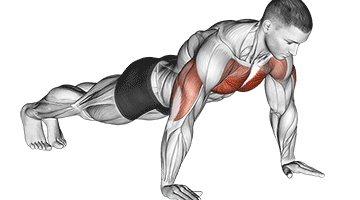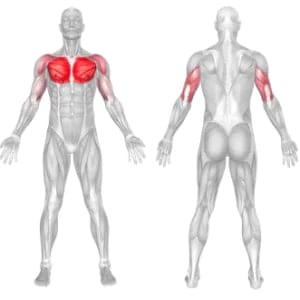Push-Up
Exercise List / Chest
Push-Up
A push-up is a exercise that involves lifting and lowering your body using your arms. They are commonly used to build upper body strength, improve core stability, and enhance overall physical fitness. Push-ups can be performed virtually anywhere and require no special equipment, making them a convenient exercise for home workouts or when you don’t have access to a gym.
How to do :

following these tips and tricks
- Starting Position:
- Begin by getting into a plank position with your hands placed on the floor, slightly wider than shoulder-width apart.
- Your body should form a straight line from your head to your heels. Engage your core muscles to maintain stability.
- The Descent:
- Lower yourself until your chest is just above the floor or as far as you can comfortably go while maintaining proper form. Your elbows should be at about a 45-degree angle to your body.
- Push:
- Push your body back up to the starting position by straightening your arms. Exhale as you push up.
- Fully extend your elbows without locking them at the top of the movement.
- Repeat:
- Perform multiple repetitions of push-ups, aiming for a full range of motion and maintaining good form throughout.
Tips for Proper Form:
- Keep your body in a straight line from head to heels.
- Don’t allow your lower back to sag or your hips to rise excessively.
- Maintain a neutral neck position by looking at a spot on the floor a few inches in front of your hands
- Breathe in as you lower your body and exhale as you push back up.
- If you’re new to push-ups, you can start with your knees on the ground for a modified version to build strength before progressing to standard push-ups.
Push-up Benefits
- Strengthens Chest Muscles: Push-ups primarily target the pectoral muscles (chest), helping to build and tone the chest muscles, which can improve your upper body strength and appearance.
- Strengthens Triceps: Push-ups also engage the triceps, the muscles at the back of your upper arm. This helps to strengthen and tone these muscles.
- Strengthens Shoulders: The anterior deltoids in your shoulders are engaged during push-ups, contributing to shoulder strength and stability.
- Core Stability: Push-ups require you to engage your core muscles to maintain a straight body position. This helps improve core strength and stability.
- Improves Posture: Strengthening the chest, shoulders, and core can lead to improved posture, as these muscles play a key role in maintaining an upright position.
- Enhances Upper Body Endurance: Regular push-up practice can increase your upper body endurance, allowing you to perform other exercises and activities more effectively.
- Boosts Metabolism: Like other strength-training exercises, push-ups can help increase your metabolism, which may assist with weight management and fat loss.
- Increases Bone Health: Weight-bearing exercises like push-ups can help improve bone density, reducing the risk of osteoporosis as you age.
- Low Impact: Push-ups are generally low-impact, making them suitable for individuals with joint issues or those who want to avoid high-impact exercises.
- Functional Strength: Push-ups mimic functional movements, such as pushing a heavy object or getting up from the ground. This can improve your ability to perform everyday activities.
- Improved Mental Health: Exercise, including push-ups, can release endorphins, which are natural mood lifters. Regular physical activity is associated with improved mental well-being and reduced stress.
- Heart Health: Engaging in regular exercise like push-ups can contribute to better cardiovascular health by lowering the risk of heart disease and improving blood circulation.
Push-up – Muscles Worked

0 %
Target - Pectoralis Major, Sternal
0 %
Synergists - Pectoralis Major, Clavicular
0 %
Synergists - Anterior Deltoid
0 %
Synergists - Triceps Brachii
0 %
Synergists - Trapezius
0 %
Dynamic Stabilizers - Biceps Brachii
0 %
Stabilizers - Rectus Abdominis
0 %
Stabilizers - Pectoralis Minor
0 %
Stabilizers - Pectoralis Minor
0 %
Antagonist Stabilizers - Erector Spinae
